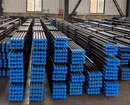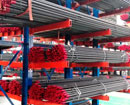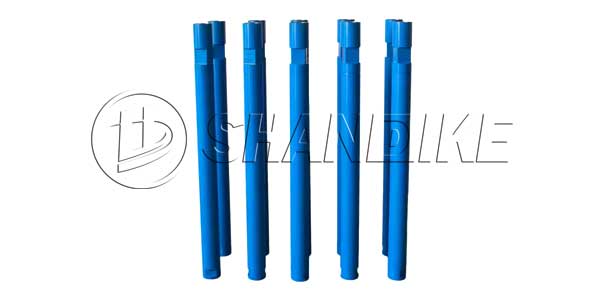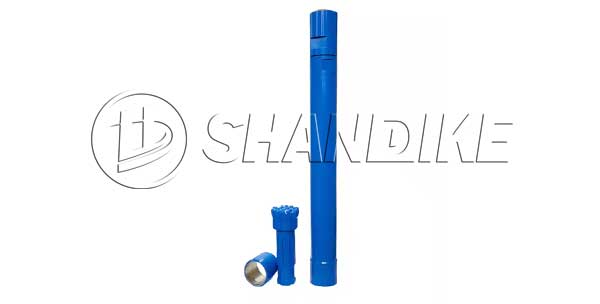Solutions
-

- Drilling Tools T38 3660Mm MM
Drilling Tools T38 3660Mm MM MF Thread...
-

- Hex22 Pneumatic Rock Drilling Tool
Small Hole Drillig Tools Hex22 7/11/12 Degrees Tools Taper Drill Rod...
Reverse Circulation DTH Hammer Working Principle
Date: 2024-10-24 Source: SDK Author: admin
The working principle of the Reverse Circulation DTH Hammer mainly relies on compressed gas drive. Specifically, compressed gas enters the impactor through the drill rod and is then discharged from the drill bit. The discharged exhaust gas is not only used for slag discharge, but also for flushing the rock sample up to the surface 12 along the annular space between the impactor and the hole wall through a movable joint.
The advantages of the Reverse Circulation DTH Hammer include:
High drilling efficiency: 2-10 times higher than hydraulic impactor and diamond rotary drilling efficiency, because the single impact energy is large, there is no liquid column pressure, the slag discharge wind speed is high, the hole bottom is clean, and there is no secondary crushing.

Long lifespan of drill bit: The column tooth hard alloy drill bit used has a longer lifespan when drilling in hard and fractured rocks.
High verticality of drilling: With low drilling speed and low centrifugal force, the impact of hole inclination on fractured or inclined formations is reduced, and the verticality of the drilling hole is improved by 3.
Environmental Protection: Adopting liquid free circulation dry operation, it does not pollute the environment and prevents large rock blocks from sliding on the slope.
Low energy consumption: Low energy consumption, high impact energy, and high energy transfer efficiency.
Strong chip removal ability: Strong chip removal ability and high drilling efficiency.
Reduce in hole accidents: Reduced the occurrence of in hole accidents by 4.
Efficient and pollution-free sampling of rock and mineral samples: Efficient and pollution-free sampling of rock and mineral samples.
The application scenarios of reverse circulation down the hole impactor include drilling operations in municipal roads, railways, highways, hydropower and other fields
| Hammer | BD351 | RC3.5 | BD004 | BD542 | BD543 | BD545 | BD040 | BD52 | BD54 | A67 | |||||||||||
|---|---|---|---|---|---|---|---|---|---|---|---|---|---|---|---|---|---|---|---|---|---|
| Top sub thread | R3″ | R3″ | R3.5″ | R4″ | M4″ | R3.5″ | R4″ | M4″ | R4″ | M4″ | M4.5″ | R4.5″ | M4″ | R4″ | M4.5″ | R4.5″ | M4.5″ | R4.5″ | M4.5″ | R4.5″ | M4.5″ |
| Package case size, mm |
(L)1100 (W)110 (H)120 |
(L)1230 (W)120 (H)150 |
(L)1300 (W)150 (H)180 |
(L)1230 (W)140 (H)170 |
(L)1260 (W)150 (H)180 |
(L)1300 (W)150 (H)180 |
(L)1300 (W)160 (H)190 |
(L)1300 (W)160 (H)190 |
(L)1330 (W)160 (H)190 |
||||||||||||
| Recommended bit size, mm |
86-100 | 100-110 | 111-125 | 113-133 | 123-140 | 127-140 | 133-143 | 136-146 | 136-146 | ||||||||||||
| Bit shank | RE351 | RC3.5 | RE004 | RE542 | RE543 | RE545 | RE040 | PR52 | PR54 | BD67 | |||||||||||
| External diameter, mm |
81 | 94 | 107 | 109.5 | 116 | 117.5 | 121 | 120.5 | 130 | 132 | |||||||||||
| Length excl. thread, mm (Less bit) |
1069 | 1184 | 1252 | 1191 | 1261 | 1210 | 1227 | 1294 | 1200 | ||||||||||||
| Hammer weight, kg (Less bit) |
29 | 44 | 52 | 57 | 63 | 65 | 53.8 | 47.5 | 69.4 | 69.4 | 68.5 | 84.5 | 81.8 | ||||||||
| Piston weight, kg |
4.8 | 8.3 | 10.5 | 11.6 | 11.6 | 13.5 | 13.6 | 14.3 | 17 | 17 | |||||||||||
| Wrench flat, mm |
No Wrench Flat |
(L)82 (W)40 |
(L)90 (W)45 |
(L)90 (W)45 |
(L)90 (W)45 |
(L)95 (W)45 |
(L)95 (W)45 |
(L)95 (W)50 |
(L)95 (W)45 |
(L)95 (W)50 |
(L)102 (W)50 |
(L)102 (W)50 |
(L)94 (W)50 |
(L)94 (W)50 |
(L)94 (W)50 |
(L)94 (W)50 |
(L)94 (W)50 |
(L)94 (W)50 |
(L)100 (W)50 |
(L)100 (W)50 |
(L)95 (W)51 |
| Drilling conditions and project specifications may require larger air packages to be used | |||||||||||||||||||||

